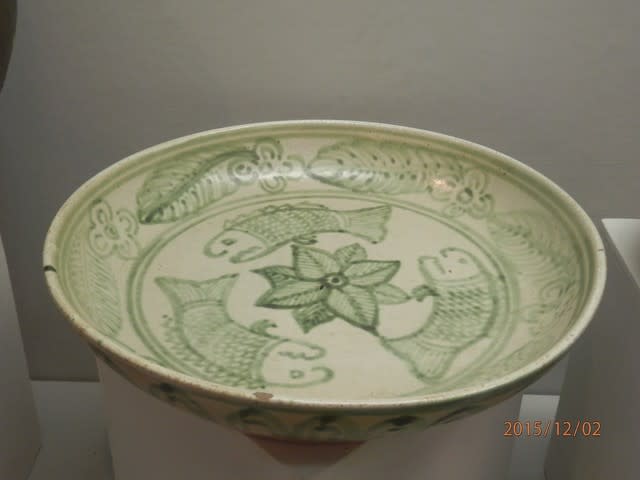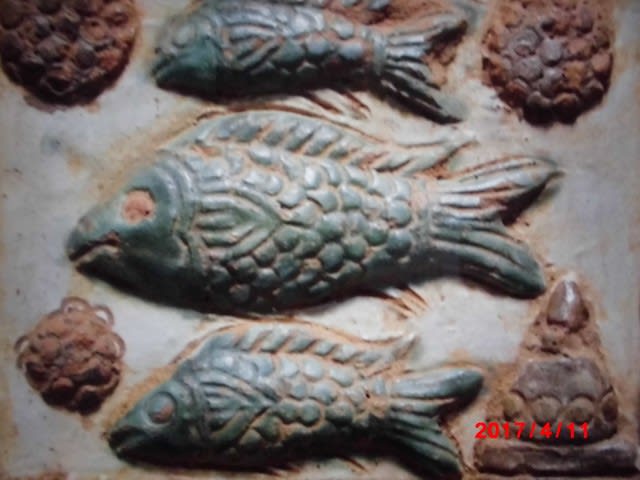South sea (South east Asian) old ceramics have fish patterns. Many are twin fish patterns. I am thought that the influence of the twin fish palace which is the zodiac signs of Indian origin is thought, but there are many things where the twin fish were placed in the 【陰陽:Yin and Yang】, and it is generally thought of as influence of China.
On the other hand, there are many single fish patterns. We can see a single fish pattern in the kiln of various parts of the South east Asia, but I feel Sukhothai ceramics is more than that.
Along with that single fish pattern, you can also see three fish patterns. I will not introduce much, but I would like to introduce the representative three fish patterns below.

(Sankampaeng ceramics ware:Kamuraten collection)
More than ten years ago, I was surprised to see this plate from the director at the Southeast Asian Ceramics Museum in 【京都・北嵯峨:Kitasaga Kyoto】. With the three fish patterns so as to be migrating to the right in the cavetto, grass is drawn in the center, but these heads (the bottom lower part) is fish, strictly speaking is four fish pattern. This design is outstanding in Sankampaeng.
There are other three fish pattern of cavetto. Below is three fish pattern of Si Satchnalai.

(at BKK university South East ceramics museum)
There are few examples of introductions, but examples in the above are present in northern Thailand. The three fish pattern can also be seen in Myanmar ceramics.

(Tin-Lead glazed green color three fish pattern plate: Haripunchai national museum)
Exvavated ceramics ware from the ruins of Myanmar (although it seems to be a robbery in many cases) was fired for a long period of time, but the lower three fish pattern seems to be around the 15th and 16th centuries.


(Net auction exhibition tile)
In general, there are many pairs of animal warrior statues and a pair of female statues, but for some reason it is three fish pattern. I am introduced some three fish pattern.
They are Thai and Myanmar ceramics, and Khmer and An Nan Ceramics do not see three fish pattern ... There are doubts as to why this is three fish pattern with the question that this is why.
This seems to be the influence of the West. It will be Trimurti. It is Hindus theory. Trimurti is that Brahma, Vishnu and Shiva are the same and these gods are equal in power relationship and are only three aspects that differentiate functions manifested from a single sacred existence It is a theory.
In other words, the three fish can be regarded as brahma, vishnu and shiva. This Trimurti will be the same as the Trinity of Judea. Especially in Judaism we regard three as a sacred number.
Trimurti would have been incorporated into Buddhism as well. Sampo 【三宝】is that. Sampo are Buddha, Law, Monk. Being a Buddhist by devoting to Sampo.
In this way, three fish pattern will be affected by the West. However, there are three fish pattern in China.

The picture is a wooden lacquered cup of early Han (2nd century before), excavated from 【Hubei Province:湖北省荊州市江陵鳳凰山168号墓】, three fish are migrating clockwise.
In the 2nd century BC it is before the Buddhist arrival to China. Therefore it is unlikely that it is the influence of the three of sacred number in the west, but was three fish pattern independently created in China? · · · It does not have an accurate answer.
In China, "three" means that the pronunciation is similar to "property", so it means that it has accumulation and good fortunate. Together the eggs of fish are prolific, which means family prosperity. It seems that it was adopted as a pattern.
So I wrote that three fish patterns appear in Myanmar and North Thailand, the influence of the West will be great.
However, a climate that can not be explained by itself is present in the southern part of Yunnan and northern Indochina, also in northern Thailand. It can be seen in ornaments worn by hill tribes.
The case to introduce is considered to be a very few part, one is the necklace designed the fish of the Lisu tribe, the second is the same necklace of the Thai tribe in northern Vietnam as seen in the Hanoi women's museum.

(Necklace Lisu people: Ciangmai hill trive museum)

(Necklace Thai people: Hanoi Women's museum)
Many of these hill tribes are people who have been chased by Chinese (Han tribe) and escaped to the south or southwest. Whether the motif of this fish is influenced by the 【Han tribe :漢族】or the creation of hill tribe, I do not have the technique to know the details, but can also be read as if they have influenced each other mutually.
The next picture is to complicate the story.

(Necklace,Unknown ethnicity name: KL national museum)
It is a necklace seen at the Islamic Art Museum in Kuala Lumpur. There is no ethnic name in caption. It can be thought of as an ethnic group of the Malay Peninsula.
Trying to think about it in the ancient times the influence of West and India, that is, Brahmin or Hindu. Therefore, although it is considered as an easy conclusion, it seems that ancient people were brothers of all ethnicities and had a similar ethnic story. Although it was a story without a conclusion, it seems that the fortune story like three and three fish were global.
<End>









